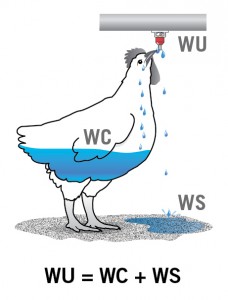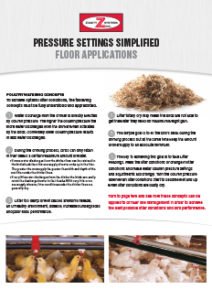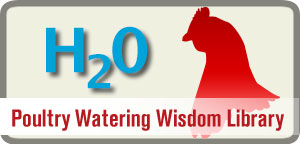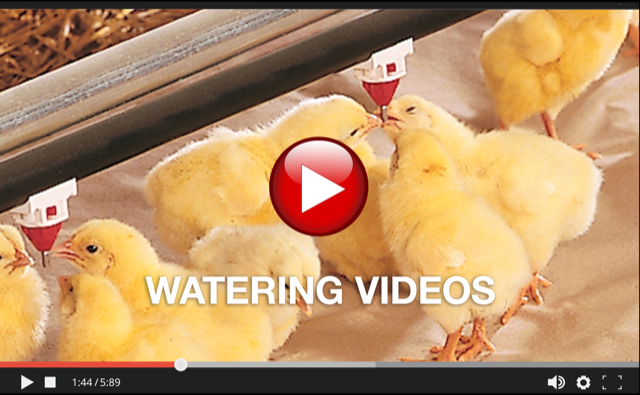 Water usage is not the same as water consumption. An appreciation and understanding of this important difference is central to effectively managing nipple-type poultry watering systems. Unfortunately, all too many in the poultry industry, including producers, field technical staff and industry suppliers, often fail to appreciate or recognize this distinction and, as a consequence, production results are compromised.
Water usage is not the same as water consumption. An appreciation and understanding of this important difference is central to effectively managing nipple-type poultry watering systems. Unfortunately, all too many in the poultry industry, including producers, field technical staff and industry suppliers, often fail to appreciate or recognize this distinction and, as a consequence, production results are compromised.
Water Usage = Water Consumption + Water Spillage (WU=WC+WS)
Water usage is the total amount of water going into a poultry facility’s drinker lines. Once in the drinker lines, two things happen to the water. During the drinking process, a certain percentage of the water is consumed or ingested by the birds. This can be truly categorized as water consumption. At the same time, a certain percentage of this water is spilled — it is not consumed or ingested by the birds. Click here to see video.
A bird’s beak size limits it’s water intake capacity (See video)
When a bird pecks the drinker’s trigger pin, water discharges from the drinker. If the discharged water is equal to or less than the volume that can be retained in the bird’s beak, little or no water is spilled. However, if the water discharged is greater than what can be retained in the bird’s beak, this oversupply results in water spillage. So when a poultry producer measures the amount of water going through the water meter, he or she is measuring water usage — the water going into the poultry facility that includes both water consumption and water spillage.
Lack of understanding leads to a crucial mistake
Poultry producers know that the more water birds consume the more they eat and, as a consequence, the faster and bigger the birds grow. If the producer equates water meter readings as water consumed by the birds, then he may increase watering line column pressure in order to increase water discharge from the drinkers (confirmed by meter readings) so bird weights will increase. The problem is that, unless the birds’ beaks have grown dramatically in size and can retain all the increased water discharge, all the producer really achieves is an increase in spillage, not in water consumption. In other words, water consumption (WC) has likely remained the same, but water spillage (WS) and water usage (WU) have increased.
The greater the spillage amount, the greater the adverse effects.
It is an unrealistic goal for 100 percent of the water that goes into a poultry facility to be consumed or ingested by the birds. This will never happen. But managing your watering system so that only five percent of water usage is spilled is better than 15 or 25 percent spillage. While the water meter will not tell you how much water is spilled, your eyes will. Producers need to continually monitor the litter moisture directly under the watering lines and manage the pressure settings and line height in a manner that minimizes spillage. The key thing to remember: a lower pressure setting causes less spillage and a higher pressure setting causes more spillage.Water spillage causes wet litter and increased ammonia release. Once this happens, water spillage compromises the litter the birds walk and sleep on, which in turn promotes disease, breast lesions and pododermatitis, as well as a host of other production challenges and environmental related problems.
For detailed information on best management practices to guard against spillage and maintain the best possible production environment, simply click here for our “Pressure Settings Simplified” procedure. And again, refer to our video.
FORGET THE MYTHS
Myth: Water meters measure water consumption
Truth: Water meters measure usage, which includes water consumed AND spilled.
Myth: Increasing drinker discharge will increase water consumption.
Truth: Water consumed is limited by beak size. Discharging more water than the beak can hold simply promotes spillage.
Myth: Dry litter always mean birds need more water.
Truth: Aggressive ventilation, heating, etc. can mask significant spillage, keeping litter artificially dry.
Myth: Flow rate is a valid concept for evaluating drinkers.
Truth: A drinker flow rate test is an invalid procedure that does not predict actual water consumed by birds. As such it can not be an effective management tool.













